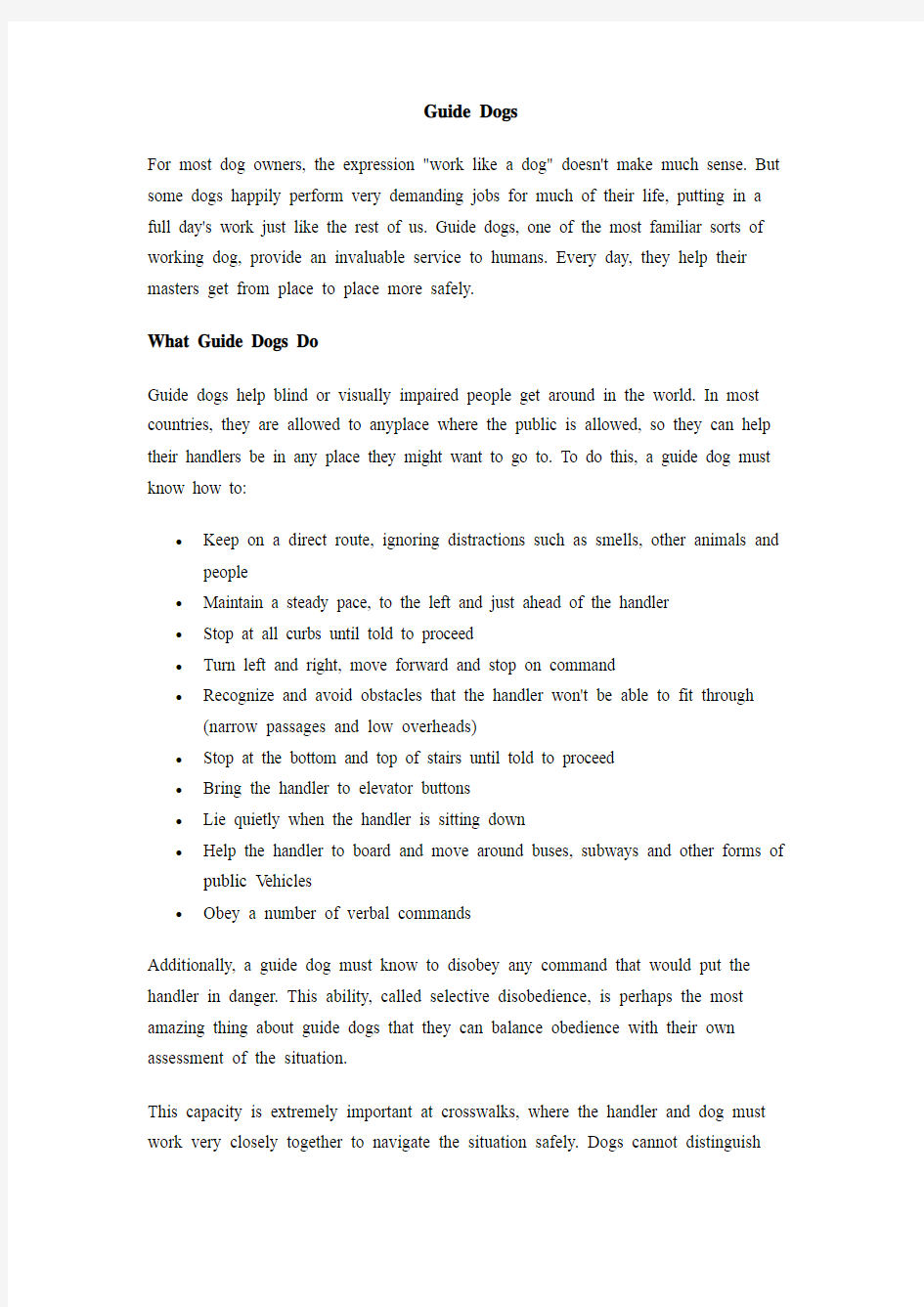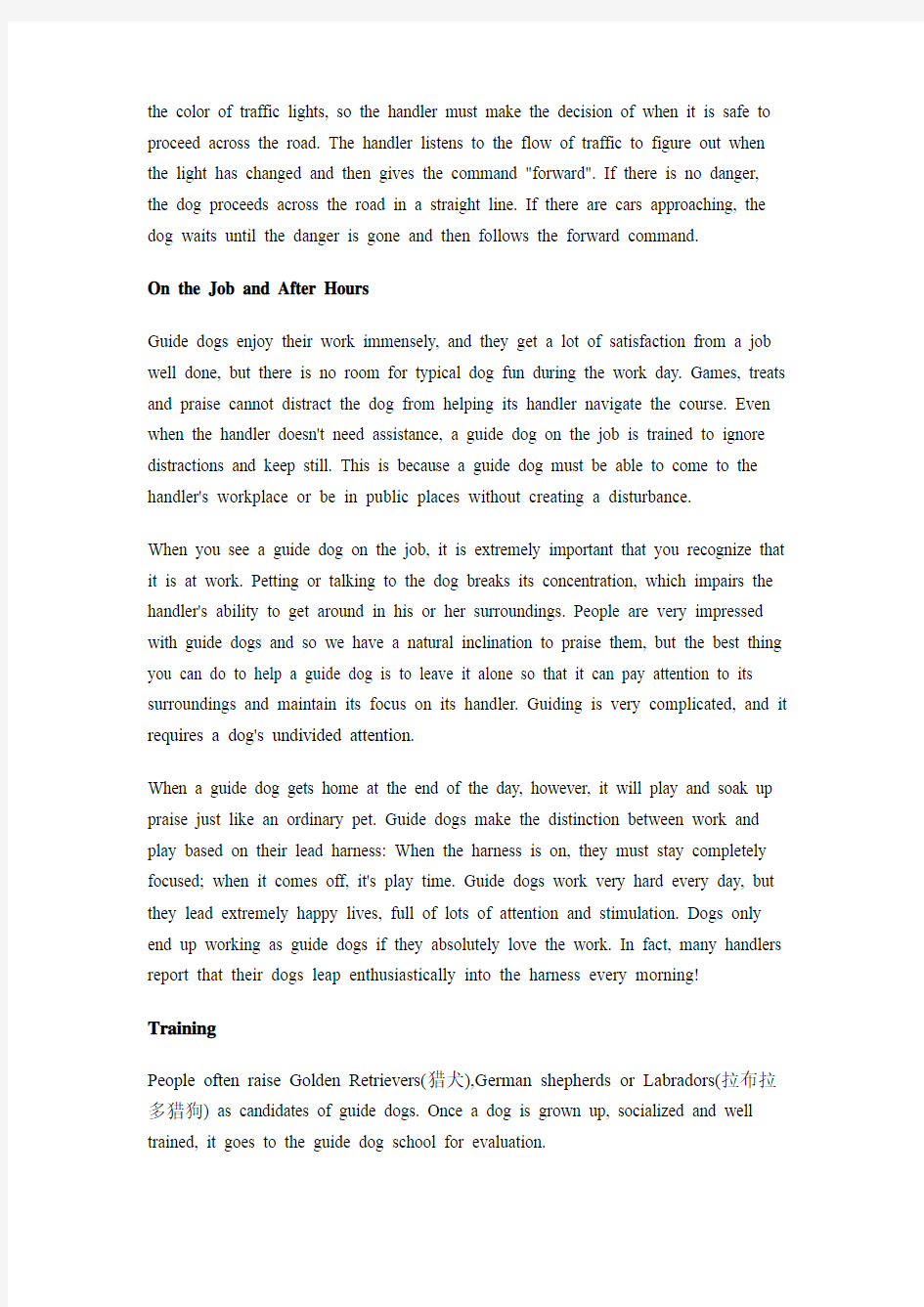Guide Dogs


Guide Dogs
For most dog owners, the expression "work like a dog" doesn't make much sense. But some dogs happily perform very demanding jobs for much of their life, putting in a full day's work just like the rest of us. Guide dogs, one of the most familiar sorts of working dog, provide an invaluable service to humans. Every day, they help their masters get from place to place more safely.
What Guide Dogs Do
Guide dogs help blind or visually impaired people get around in the world. In most countries, they are allowed to anyplace where the public is allowed, so they can help their handlers be in any place they might want to go to. To do this, a guide dog must know how to:
?Keep on a direct route, ignoring distractions such as smells, other animals and people
?Maintain a steady pace, to the left and just ahead of the handler
?Stop at all curbs until told to proceed
?Turn left and right, move forward and stop on command
?Recognize and avoid obstacles that the handler won't be able to fit through (narrow passages and low overheads)
?Stop at the bottom and top of stairs until told to proceed
?Bring the handler to elevator buttons
?Lie quietly when the handler is sitting down
?Help the handler to board and move around buses, subways and other forms of public V ehicles
?Obey a number of verbal commands
Additionally, a guide dog must know to disobey any command that would put the handler in danger. This ability, called selective disobedience, is perhaps the most amazing thing about guide dogs that they can balance obedience with their own assessment of the situation.
This capacity is extremely important at crosswalks, where the handler and dog must work very closely together to navigate the situation safely. Dogs cannot distinguish
the color of traffic lights, so the handler must make the decision of when it is safe to proceed across the road. The handler listens to the flow of traffic to figure out when the light has changed and then gives the command "forward". If there is no danger, the dog proceeds across the road in a straight line. If there are cars approaching, the dog waits until the danger is gone and then follows the forward command.
On the Job and After Hours
Guide dogs enjoy their work immensely, and they get a lot of satisfaction from a job well done, but there is no room for typical dog fun during the work day. Games, treats and praise cannot distract the dog from helping its handler navigate the course. Even when the handler doesn't need assistance, a guide dog on the job is trained to ignore distractions and keep still. This is because a guide dog must be able to come to the handler's workplace or be in public places without creating a disturbance.
When you see a guide dog on the job, it is extremely important that you recognize that it is at work. Petting or talking to the dog breaks its concentration, which impairs the handler's ability to get around in his or her surroundings. People are very impressed with guide dogs and so we have a natural inclination to praise them, but the best thing you can do to help a guide dog is to leave it alone so that it can pay attention to its surroundings and maintain its focus on its handler. Guiding is very complicated, and it requires a dog's undivided attention.
When a guide dog gets home at the end of the day, however, it will play and soak up praise just like an ordinary pet. Guide dogs make the distinction between work and play based on their lead harness: When the harness is on, they must stay completely focused; when it comes off, it's play time. Guide dogs work very hard every day, but they lead extremely happy lives, full of lots of attention and stimulation. Dogs only end up working as guide dogs if they absolutely love the work. In fact, many handlers report that their dogs leap enthusiastically into the harness every morning!
Training
People often raise Golden Retrievers(猎犬),German shepherds or Labradors(拉布拉多猎狗) as candidates of guide dogs. Once a dog is grown up, socialized and well trained, it goes to the guide dog school for evaluation.
In some schools, if a dog is suited for training but not quite ready, it may go back to the puppy raiser for a month or so to mature. If a dog is simply not suited for training, the school will work to place the dog in another line of work, such as tracking, or find it a permanent home, usually offering it to the puppy raiser first. At Guiding Eyes for the Blind, only the top 50 percent of the puppies will stay with the school. So the school places a little over 400 puppies with raisers each year, needing only 200 dogs for the training program. Of that 200,a small percentage will become breeding stock, for Guiding Eyes or another school, and the rest will be considered for the training program.
Training is a rigorous process for both the instructors and the dogs, but it's also a lot of fun. To make sure the dogs are up to the challenge, most schools test them extensively before beginning the training. The tests are designed to assess the dogs' self-confidence level, since only extremely confident dogs will be able to deal with the pressure of guiding instruction. If a dog passes the tests, it begins the training program right away.
Different schools have different programs, but typically, training will last four to five months. To make sure the dogs master all the complex guide skills, the instructors have to introduce them to each idea gradually. Once they have introduced what is expected of the dog, training is essentially a matter of rewarding correct performance and punishing incorrect performance. This works with dogs because they are pack animals and have a natural need to please an authority figure. The instructor, or later the handler, is simply stepping into the place of the alpha dog, the leader of the pack.
Unlike ordinary obedience training, guide dog training does not use food as a reward for good performance. This is because a guide dog must be able to work around food without being distracted by it. Instead, instructors use praise or other reward systems to encourage correct performance. The standard means of correction is pulling on the dogs leash, so that it pulls a training collar, giving the dog a slight pinch(捏,
掐).Using this basic reward/punishment system, instructors work through the necessary skills for guiding.
Forming a Team
The final stage of a guide dog's training is learning to work with its new master. Guide dog training schools work very hard to match handlers with guide dogs according to the compatibility of their personalities. A very energetic dog typically does well with a young handler, while an older handler may need an especially careful partner. Schools often have a special gathering to commemorate the time when a new class of guide dogs finally meets their masters. Often, the dogs' puppy raiser attends and meets with the new master as well. This is perhaps the most emotional time in the entire training process.
After this introduction, guide dog instructors typically spend a month helping the new team learn to work together. Many schools have dormitories for the handlers to stay in during this final stage of training.
If the handler has never used a guide dog before, a lot of the instructors work at this point are actually people training, not dog training. The handler has to learn to read the dogs movements, so he or she knows when the dog is turning or when the dog is stopping for a crosswalk or stairs. Additionally, the handler has to learn all the commands the dog knows, and must get some practice walking with the dog. The dog has to make the transition from obeying the instructor to recognizing the handler as its new master. The handler and the dog spend a lot of this time just getting to know each other, so that they are comfortable enough to work as a team. By the time they graduate from the guide dog school, they can read each others every movement.
Notes:
1. impaired: diminished in strength, quality, or utility;
1. puppy: a young dog.
Questions:
1. What is the best thing you can do for it, when you see a guide dog work very well?
2. How does a guide dog tell the time of play apart from that of work?
3. What’s the differ ence between the guide dog from other dogs?
(https://www.360docs.net/doc/202034871.html,/html/exam/cet6/2008/1203/6342.html)
